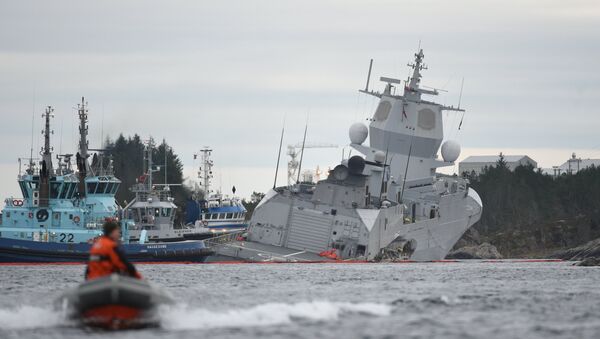While returning from the major NATO drill Trident Juncture, where it took part in anti-submarine training in the seas northwest of Trondheim, the Norwegian frigate KMN Helge Instad collided with the Malta-registered tanker vessel Sola TS, prompting a dramatic operation spanning several hours to stop fuel leakage and save one of the latest additions to the Norwegian fleet from sinking, the daily newspaper Aftenposten reported.
The collision occurred just outside an oil terminal at Oygarden in Hordaland, resulting in a halt in all shipping activity during the rescue operation, as several important oil and gas fields in the North Sea were closed. In total, these five oil and gas fields combined produce around NOK 400 million ($48 million) a day or NOK 17 million ($2 million) an hour. Since the oil companies pay 78 percent taxes to the state for production, the shutdown ultimately resulted in a substantial economic loss for the nation, national broadcaster NRK reported.
All the 137 people on board the KMN Helge Instad were successfully evacuated, with eight sailors sustaining injuries.
Norwegian Navy frigate HNoMS Helge Ingstad collided with oil tanker in Sture, north of Bergen, Norway.The warship was returning from #NATO #TridentJuncture exercises. All 137 crew have been evacuated. pic.twitter.com/Ji1F90OFoP
— Military Advisor (@miladvisor) 8 ноября 2018 г.
The KMN Helge Ingstad is one of five Nansen-class frigates built at the Spanish shipyard Navantia in Ferrol and delivered with serious delays in 2009. It was billed as 'unsinkable' due to its construction with water-tight zones designed to keep the vessel 'intact and operable'. Ironically, the vessel took part it a 'high visibility' exercise shortly before the accident.
READ MORE: 'S****y Job': Norwegians Grumble Over Defecating NATO Soldiers During Mega Drill
How a contemporary warship could collide with a small civilian tanker in clear weather and calm seas remains a tough question for the Navy to answer. Military personnel were mostly reticent about the incident, and multiple investigations are underway. Maritime experts, such as retired Commander Jacob Borresen, found the collision 'inexplicable'.
"The fact that it happened in this particular area is incomprehensible. Here we have a traffic centre packed with radar monitoring equipment reading transponder signals from all the vessels in the area. The frigate had state-of-the-art radar equipment and infrared optical systems. How is it possible that the vessels didn't see each other?" a puzzled Børresen wondered in an interview with NRK.
Aerial footage of the Helge Ingstad frigate. pic.twitter.com/tiFk2M6Sn8
— Military Advisor (@miladvisor) 8 ноября 2018 г.
The KMN Helge Ingstad received a nearly 10-meter-long gash on its starboard side and was maneuverer into a shallow coastal bay, where it remains lying on the side. The accident triggered speculations that helicopters stored under the deck may have been ruined together with other sensitive equipment in the engine room. Nansen-class frigates cost the Norwegian state coffers about NOK 3.5 billion ($420 million) each, not counting the helicopters. For the sake of comparison, the Norwegian parliament granted NOK 4.1 billion ($490 million) to the entire Navy in 2018.
While Borresen called the collision a 'tragic accident', the Norwegian press described it as a national disaster in terns of military, financial and reputational losses.


